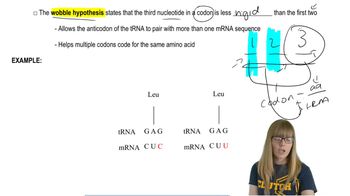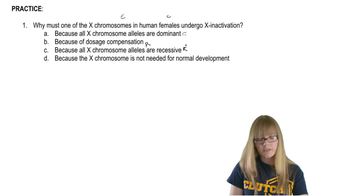Here are the essential concepts you must grasp in order to answer the question correctly.
Lyon Hypothesis
The Lyon hypothesis, also known as X-inactivation, is a genetic phenomenon that occurs in female mammals where one of the two X chromosomes is randomly inactivated during early embryonic development. This process ensures dosage compensation between males (who have one X chromosome) and females (who have two). The inactivated X chromosome condenses into a structure called a Barr body, which is largely transcriptionally inactive.
Recommended video:
Translation:Wobble Hypothesis
Dosage Compensation
Dosage compensation is a biological mechanism that balances the expression of genes on sex chromosomes between males and females. In mammals, this is achieved through X-inactivation, where one X chromosome in females is silenced to prevent an overexpression of X-linked genes. This ensures that both sexes have a similar level of gene expression from their X chromosomes, which is crucial for normal development and function.
Recommended video:
Purpose of X Inactivation
Barr Body
A Barr body is the inactive X chromosome in a female cell, which becomes highly condensed and transcriptionally inactive after X-inactivation. This structure can be observed in the nuclei of female somatic cells and serves as a visual marker of X-inactivation. The presence of Barr bodies is a key feature in understanding the Lyon hypothesis and the mechanisms of dosage compensation in mammals.
Recommended video:
Other Chromatin Modifications
 Verified step by step guidance
Verified step by step guidance Verified video answer for a similar problem:
Verified video answer for a similar problem:

